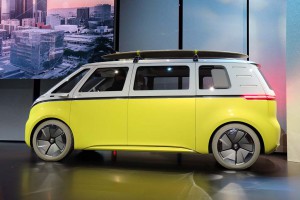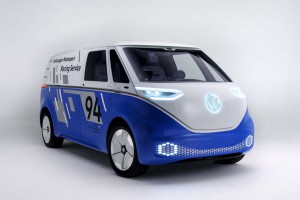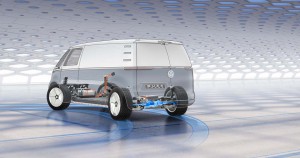In its push into electrification, Volkswagen plans to bring back a retro-futuristic version of its legendary Microbus, the all-electric I.D. Buzz. And, at the Los Angeles Auto Show this week, the German automaker will reveal a commercial version of the van it is calling the I.D. Buzz Cargo.
The commercial version will offer as much as 340 miles of battery range — which it says can be extended by the use of a solar roof. The I.D. Buzz Cargo also will feature full autonomous driving capabilities, according to a VW statement released ahead of the commercial van’s formal unveiling in L.A. on Wednesday.
“The Cargo could be launched as a production vehicle in Europe as early as 2022,” VW said. It did not confirm whether it plans to bring the commercial version of the I.D. Buzz to the U.S. market, as well, however.
Volkswagen is making a major commitment to electrify, with as many as 50 different all-electric models due to market by the middle of the coming decade. That will include offerings sold through its various brands – such as the Audi e-tron GT which will also debut in Los Angeles this week – though the majority will carry the familiar VW logo and be sold through the new “I.D. Family.”

The I.D. Buzz Cargo is designed to handle all of the needs for a small business owner who needs a small van.
(Click Here for a preview of the Audi e-tron GT.)
We got a first look at the production version of the I.D. Buzz at the North American International Auto Show in Detroit in January 2017. (The name, Buzz, is a play on the German pronunciation of the word, “bus,” VW explained, adding that it also refers to the sound of the show car’s twin electric motors, one for each axle.)
The Buzz bears an unmistakable resemblance to the classic VW Microbus, though the nose is less blunt – allowing it to meet modern crash standards, while also improving aerodynamics. The commercial version loses most of its windows, much like other cargo vans, but retains the passenger van’s overall shape.
The I.D. Buzz Cargo is also about four inches longer, measuring 198.7 inches long, 77.8 in wide and 77.3 in tall, with a wheelbase of 129.9 inches. Unlike the 22-inch wheels on the passenger Buzz, the Cargo has 20-inch commercial wheels and tires. In concept form, the Cargo has a payload of 1,760 pounds.
Inside, VW notes, the Buzz Cargo has been “tailored for commercial use,” starting with a 1+2 front seating layout. That includes a driver’s bucket and a passenger bench that can have its center half folded down. A built-in workbench can pulled out of the back, once the symmetric rear barn doors are opened.
(CEO says VW ready to build 50 million EVs. Click Here for the story.)
VW says the Cargo will be offered with a variety of different lithium-ion battery pack options, ranging from one of a modest 48 kilowatt-hours, all the way up to 111 kWh. In turn, those would provide the ability to travel anywhere from 200 to 340 miles per charge – using the European test cycle, and likely less in the U.S. on the EPA test.
The automaker also notes that one of the features of the I.D. Buzz Cargo concept is a solar roof it claims could add as much as 9.3 miles of daily driving range. The van also has a 230-volt electric socket to power things like a worker’s tools.

Volkswagen unveiled the I.D. Buzz Concept at the 2017 North American International Auto Show in Detroit.
During manual operation, the Buzz Cargo’s main controls are located on the steering wheel, with a 3D Augmented Reality, or AR, head-up display projecting key information on the windshield. Conventional sideview mirrors, meanwhile, have been replaced by cameras using small screens inside the cab. That would help reduce air drag and boost range.
The Cargo also features I.D. Pilot mode, activated by “simply pushing on the steering wheel for a few seconds, which then retracts into the instrument panel. Then the driver’s seat can be turned 15 degrees to the right, enabling the on-board computer to be operated from the ideal ergonomic position.”
(To see more about VW’s plans to put the I.D. Buzz into production, Click Here.)
We hope to learn more about U.S. production plans during Volkswagen’s formal news conference at the 2018 Los Angeles Auto Show later this week.


